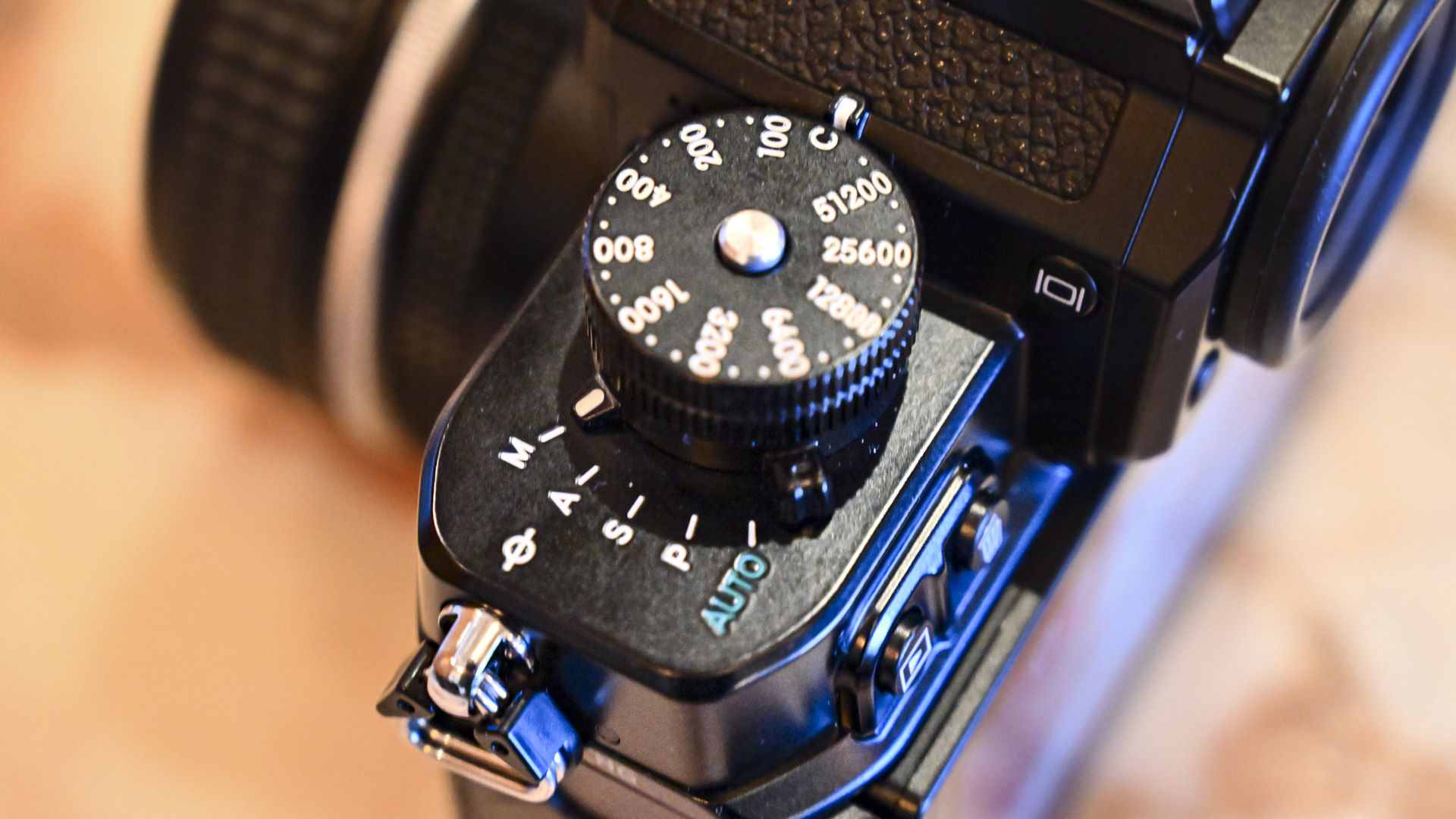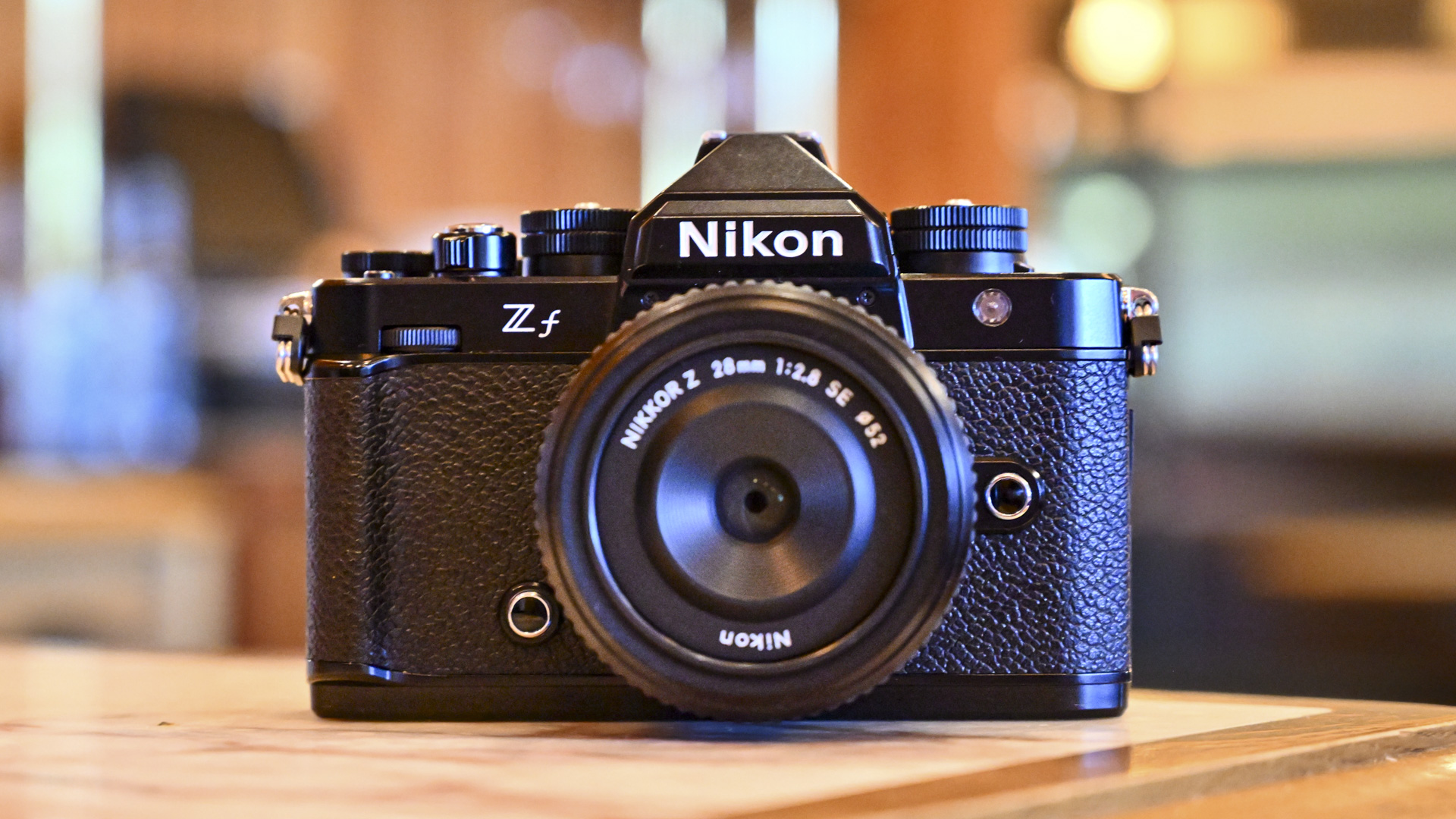Like ungrateful children, we reveled in the iconic Nikon FM2-inspired Nikon Zfc retro mirrorless camera that was unveiled in 2021, only to ask for more. Why isn’t it full-frame? Couldn’t the build quality be better?
Two years later, those wishes (ahem, demands) have come true, in the shape of the Nikon Zf. The new Zf ditches that ‘c’ from the Zfc that denotes ‘casual’ use, and is a pricier, serious, everyday camera that again looks the part if you love the film photography aesthetic, adding beautiful flourishes for the discerning eye.
I had both the Zf and Zfc in my hand during a sneak peek ahead of the latter’s worldwide announcement, and my first impressions are that the two cameras largely look and feel the same; the Zf is slightly larger, with a raised bump for a handgrip. A look into the viewfinder reveals a slightly more expansive view, too – like many of the camera’s core features, the 3.69m-dot 0.50-inch viewfinder with 0.8x magnification is inherited from the full-frame Nikon Z6 II.
The shutter button now includes a thread for screwing in a cable release – in a modern mirrorless camera world, that’s seriously old-school, and will appeal to photographers of a certain vintage. There’s also a new B&W mode on the photo and video switch that’s positioned under the shutter speed dial, and Nikon has added two new monochrome color profiles in an attempt to go toe-to-toe with Fujifilm’s ever-expanding and popular film simulation looks.
And then there’s what you can’t see: a top and front magnesium alloy chassis which makes the Zf a tougher camera than the Zfc, while the shutter speed and ISO dials are made from brass, which we’re told will weather to reveal those glorious brass-tones with prolonged use. The Zfc looks the part, but the Zf adds a bit of ruggedness that FM2 owners would expect, and is a more faithful reimagining of that legendary camera.
Features-wise, the Zf inherits a lot of its core components from the Z6 II, including a full-frame 24.5MP sensor. At the rumors stage, I had speculated that the Zf would get the 45.7MP sensor of the Z7 II, and for a camera that’s designed primarily for small lenses like the retro Nikkor Z 28mm F/2.8 SE, I wish there were more pixels to play with; that way you’d have more cropping potential in your pictures for the times when you can’t get close enough, as you get with another everyday camera, the 61MP Leica Q3.
Still, the 24.5MP full-frame sensor is a proven performer, and it’s served me well in my own Z6 II, which has been my go-to camera for events, weddings and portrait photography sessions. The Zf also gets the latest EXPEED 7 processor, as found in the excellent Nikon Z8, and intelligent autofocus, so it’ll be a speedier performer, albeit limited by its slower SD and micro SD storage media (compared to CFExpress).
Using Z6 II-level tech means the Zf list price is closer to the $2,000 / £2,000 / AU$3,500 mark, too, whereas the Z7 II is pricier by around 30%. Pitching the Zf at the Z6 II price point enables it to go directly up against Fujifilm’s best offerings, like the X-T5 so perhaps it’s a good call from Nikon after all. The Zf won’t handle as well as the Z6 II in various demanding scenarios, but it will feel the part, and bring that enjoyable and tactile experience, making it one for the wishlist.
Nikon Zf: Release date and price
The Nikon Zf body-only list price is £2,299 in the UK, or it can be purchased with the Z 40mm F2 lens for £2,519, or with the Z 24-70mm F4 lens for £2,849 (we’ll add US and Australia pricing as soon as we get it). The Zf will be available from October 2023, in black only from third-party online retailers, while if you shop at the Nikon store it comes in six color variations. There will be a handgrip accessory available too, price TBC.

Features and performance
- 4K / 30p 10-bit video or 4k / 60p with 1.5x crop
- New AI-assisted vibration reduction
- 299-point AF with wider coverage than the Z8
While its design is what sets the Zf apart from most other cameras, it’s no slouch either, and comes equipped with seriously powerful features, especially when it comes to focusing. Nikon compares the tracking AF performance to that of the flagship Nikon Z9, with subject detection including humans, animals (with eye AF), cars, motorbikes, bikes, trains and planes.
What particularly pricked my ears during a Zf features walkthrough is its subject-detection manual focus assist, which works even with vintage lenses. For example, with subject detection active in manual focus mode, the Zf can automatically jump to a magnified view of the detected eye of your subject to make it quick and easy to nail sharp manual focus. I can’t wait to try that out.
We get fewer autofocus points than in the Z8, but the 299-point AF array covers a wider area of the frame, at a 89×96% coverage – in reality you won’t ever be focusing outside of this area – and it’s more accurate than ever in low light, with a -10EV sensitivity.
Nikon also talked me through a world-first feature in the Zf: subject detection-assisted vibration reduction. My understanding is that the Zf can communicate to its 5-axis on-sensor image stabilization to adjust its axis depending on where the detected subject is in the frame, to achieve more effective vibration reduction, but I’ll unpack this in my in-depth review when I can be fully sure about my interpretation.
I’d mostly use the Zf for everyday reportage photography, and I can see the pre-release function being particularly useful for the moments you might otherwise miss, because it can record up to one second before you fully press the shutter.
The Zf is also a highly powerful camera for action sequences, with the ability to shoot up to 30fps JPEG-only, or up to 14fps in an extended continuous mode, although I don’t have the technical information on how long it can sustain those speeds for. Given that the Zf shoots onto SD card rather than the faster CFExpress, my expectations are limited.
On paper, video performance is respectable, with 4K 10-bit video from the full width of the sensor up to 30fps, although half-speed 60fps incurs a 1.5x image area crop. However, video-assist tools impress; you get a red border on the LCD to indicate recording in progress, focus peaking, zebra, waveform, and fine ISO control, plus 24-bit internal sound. Not bad for a photography-first camera.
Design
- First full-frame Nikon mirrorless with vari-angle touchscreen
- Twin SD and micro SD card slots limit shooting potential
- Uses same EN-EL15c battery as Z8
Beyond the retro-design attributes laid out in the introduction of this hands-on review, including the FM2 styling, magnesium alloy chassis, and brass exposure dials, the Zf offers cutting-edge features that we come to expect from the best mirrorless cameras in 2023.
It’s the first Nikon full-frame mirrorless camera with a vari-angle touchscreen. The screen can be flipped out to the side for easy viewing from multiple angles, or folded away completely, as if the camera had no rear screen at all – that should appeal to old-school photographers. In that setup you get to enjoy the improved leather-finish effect, which as mentioned before is available in six different colors direct from Nikon, though a Fujifilm X-Pro 3-inspired film window on that rear would be an even nicer touch.
When using the viewfinder, the Zf’s vari-angle screen’s touch functions remain active for controls such as scrolling through subjects using face-detection autofocus when multiple faces are in the frame, and toggling through display options like framing grids.
We get twin card slots, one being SD and the other micro SD. For a camera with such an advanced processor and high-speed shooting, those cards will be a limiting factor for continuous shooting when compared to the faster CFExpress type used by the Z6 II.
Like the Z8, the Nikon Zf uses the EN-EL15c battery, although we don’t have word yet on what kind of battery life to expect.
Otherwise, there’s much in common here with the Zfc, except that everything is a fraction bigger to host that larger full-frame image sensor. I prefer the size and feel of the Zf, even down to the ever-so-slightly larger top LCD, and I also rest easy in the knowledge that its build quality is slightly better, with Nikon saying the Zf boasts ‘superior dust and drip resistance’, even in harsh environments.
Image quality
- Proven full-frame sensor with improved ISO 100-64,000
- New color profiles
- Improved in-body image stabilization
My hands-on time with the Nikon Zf was very brief, and I was not permitted to take away any pictures made with the camera before its announcement. However, ahead of my in-depth review, I can make many assumptions about the Zf’s image quality, given that it uses the same 24.5MP sensor as the Nikon Z6 II, which we rated as having “excellent image quality” in our in-depth Z6 II review, performing especially well in dimly lit conditions.
Furthermore, the Zf also uses the next-generation EXPEED 7 processor and boasts improved image stabilization, up to eight stops, and greater ISO range that now goes up to ISO 64,000, so it will only build on the Z6 II in terms of image quality. However, does it offer the best image quality for a camera of its kind?
The Z6 II is a multi-purpose camera, adept for events, weddings, and portraiture, and an excellent match with the best Nikon lenses, including zoom lenses like the Z 24-70mm F2.8 S. The Zf, on the other hand, is the kind of camera you want with you everyday, one for reportage and street photography, and handles best with small lenses, especially those that are an aesthetic pairing, like the Z 28mm F2.8 SE. In that light, and with limited retro-styled Z lens availability, I would have loved the Zf to use the same higher-resolution sensor as the Z7 II, to effectively extend the reach of those small, moderate wide-angle fixed lenses.
Elsewhere, the Zf comes equipped with a pixel-shift mode that produces an ultra-sharp high-resolution image from multiple shots, provided the camera is supported to eliminate camera shake and your subjects are stationary (we don’t have the exact specs for this mode yet). And there are new color profiles and looks to choose from, including two new black-and-white profiles – flat monochrome and deep tone monochrome – plus a skin softening function, and a Rich Tone Portrait profile that accentuates skin complexion.

Early verdict
I was super-excited when the first Nikon Zf rumors circulated, and even having only had my hands on the camera for a short time, those feelings have only grown. It’s what serious photographers like me wanted all along, rather than the toy-like Zfc (although that’s a great choice for beginners); it’s a rugged and beautiful camera that puts a smile on your face, with serious power under the hood. There’s plenty that I’m looking forward to using further as I put the camera through our full review process, including subject detection-assisted manual focus and the new color profiles.
The Nikon Zf doesn’t feel like a camera I need, but it sure is one that I want.





